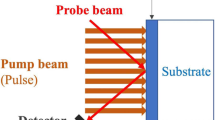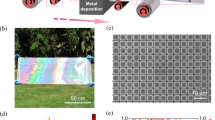Abstract
In this research, we designed a disc structure metamaterial emitter using silver and titanium dioxide for radiative cooling applications. We used COMSOL Multiphysics software for numerical simulations, considering temperature changes induced by atmospheric and surface radiation. The results of the numerical simulations demonstrated that the designed emitter had an average emissivity of 89.5% within the atmospheric transparency window, which spans from 8 to 13 µm. Furthermore, the designed emitter has the potential to achieve a radiative cooling power of 200.4 W/m2 at an ambient temperature of 300 K and can reach an equilibrium temperature of 268.25 K. Impressively, the designed emitter can cool down to 31.75 °C below the ambient temperature. Based on the results of our research, metamaterial emitter has the potential to be crucial components in the development of energy-efficient radiative cooling devices. Therefore, this work further contributes to the advancement of passive radiative coolers based on metal–dielectric–metal.








Similar content being viewed by others
References
H Yin, H Yao, Y Jia, J Wang and C Fan J. Phys. D: Appl. Phys. 54 345501 (2021)
V Chetan, K Nagaraj, P S Kulkarni, S K Modi and U N Kempaiah J. Phys.: Conf. Ser. 1473 012054 (2020)
X Liu, T Tyler, T Starr, A F Starr, N M Jokerst and W J Padilla Phys. Rev. Lett. 107 045901 (2011)
X Sun, Y Sun, Z Zhou, M A Alam and P Bermel Nanophotonics 6 997 (2017)
M Li, H B Peterson and C F Coimbra J. Renew. Sustain. Energy 11 (2019)
X Lu, P Xu, H Wang, T Yang and J Hou Renew. Sust. Energ. Rev. 65 4800 (2016)
R Family and M P Mengüç Sustainability 10 3049 (2018).
Y Li, L Li, L Guo and B An Opt. Mater. Express 10 1767 (2020)
B Ko, D Lee, T Badloe and J Rho Energies 12 89 (2019)
Y Dai, Z Zhang and C Ma Opt. Commun. 475 126231 (2020)
D Chae, M Kim, P H Jung, S Son, J Seo, Y Liu, J L Bong and H Lee ACS Appl. Mater. Interfaces 12 8073 (2020)
Suhendri, M Hu, Y Su, J Darkwa and S Riffat Buildings 10 215 (2020)
Y Zhu, Y H Ye, D Wang and Y Cao AIP Adv. 11 (2021)
M A Kecebas, M P Menguc, A Kosar and K Sendur J. Quant. Spectrosc. Radiat. Transf. 198 1339 (2017)
A Kong, B Cai, P Shi and X C Yuan Opt. Express 27 30102 (2019)
W Zhang, G Xu, J Zhang, H Wang and H Hou Opt. Mater. 37 343 (2014)
W Zhang, G Xu, J Zhang, H Wang and H Hou Appl. Phys. Lett. 81 4685 (2003)
A Bessière, C Marcel, M J Morcrette, M Tarascon, V Lucas, B Viana and N J Baffier Appl. Phys. 91 1589 (2002)
Author information
Authors and Affiliations
Contributions
All authors contributed to the study’s conception and design. The processes of conceptualizing, designing, data analysis, and interpretation were performed by all authors (WM and FT). The first draft of the manuscript was written by WM, and all authors commented on previous versions of the manuscript. All authors read and approved the final manuscript after critical revision. All authors met the requirements for authorship, and they confirm that the manuscript represents honest work.
Corresponding author
Ethics declarations
Conflict of interest
The authors declare that they have no known competing financial interests or personal relationships that could have appeared to influence the work reported in this paper.
Additional information
Publisher's Note
Springer Nature remains neutral with regard to jurisdictional claims in published maps and institutional affiliations.
Rights and permissions
Springer Nature or its licensor (e.g. a society or other partner) holds exclusive rights to this article under a publishing agreement with the author(s) or other rightsholder(s); author self-archiving of the accepted manuscript version of this article is solely governed by the terms of such publishing agreement and applicable law.
About this article
Cite this article
Minalu, W., Tolessa, F. Numerical study of high emissivity metamaterials for radiative cooling application. Indian J Phys (2024). https://doi.org/10.1007/s12648-024-03139-x
Received:
Accepted:
Published:
DOI: https://doi.org/10.1007/s12648-024-03139-x




